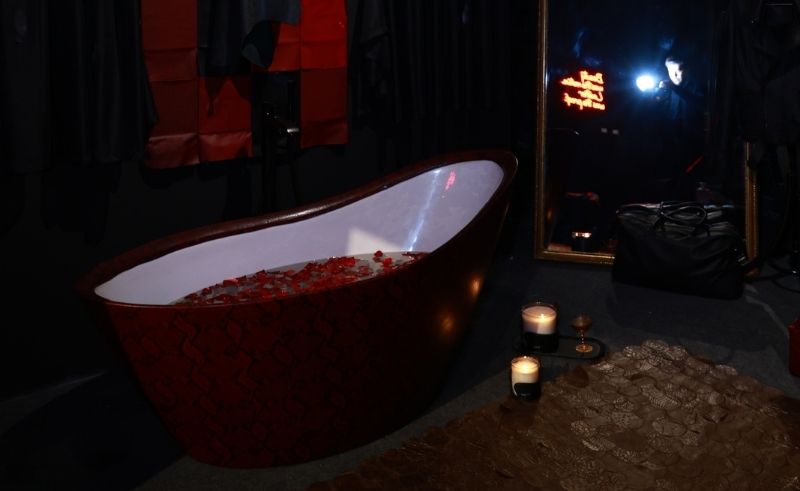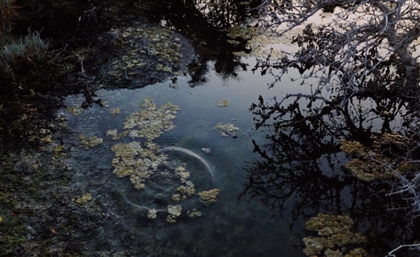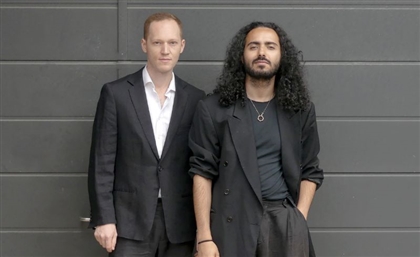Leopelle Pushes Leather Boundaries in a ‘Crime of Passion’ Hotel Room
Leopelle transforms a hotel room with unexpected leather applications in a cinematic ‘crime of passion’ setting

Stepping into the room, the building around you seems to recede and give way to a scene that feels abruptly paused. A gilt mirror stands ahead with a line of red lipstick across its surface, reading “Don’t touch my magic with your dirty hands.” It is the first signal for the staged moment.
-4587fa60-0c7e-43b0-aa5e-fe6eefc2e7ab.jpg) Leopelle, the force behind the installation, has been in the leather manufacturing business for over a century. With bases in Cairo and New York, the company has been producing handcrafted pieces that range from fashion to interiors.
Leopelle, the force behind the installation, has been in the leather manufacturing business for over a century. With bases in Cairo and New York, the company has been producing handcrafted pieces that range from fashion to interiors.
-12f9a226-6169-487e-894c-36058718559f.jpg) Architect Injie Mahdy, Chief Architect of Injie Mahdy Design Studio, describes the intention. “We wanted this to feel like a ‘crime of passion’,” she tells SceneHome. “That is why it takes the form of a dark, unapologetically messy hotel room. The concept needed a setting that could hold a story.” The installation sits inside Tamara Haus, part of the Downtown District of Cairo Design Week. The building, once the residence of Abdel Aziz Radwan Bey, was constructed in 1910 in a Renaissance Revival style.
Architect Injie Mahdy, Chief Architect of Injie Mahdy Design Studio, describes the intention. “We wanted this to feel like a ‘crime of passion’,” she tells SceneHome. “That is why it takes the form of a dark, unapologetically messy hotel room. The concept needed a setting that could hold a story.” The installation sits inside Tamara Haus, part of the Downtown District of Cairo Design Week. The building, once the residence of Abdel Aziz Radwan Bey, was constructed in 1910 in a Renaissance Revival style.
-f99472de-f52a-4634-bdf3-6dc0c0784398.jpg) Leopelle’s leather was exactly what the room needed to embody the intensity of that passionate moment. Its craftsmanship and quality transform it, shaping its atmosphere, its texture, and even its scent. Founder and CEO Ahmed Gabbas explains the premise behind it. “We work entirely with genuine leather, and what we’re presenting is a scene,” he says. “A hotel room where every element is made of leather.”
Leopelle’s leather was exactly what the room needed to embody the intensity of that passionate moment. Its craftsmanship and quality transform it, shaping its atmosphere, its texture, and even its scent. Founder and CEO Ahmed Gabbas explains the premise behind it. “We work entirely with genuine leather, and what we’re presenting is a scene,” he says. “A hotel room where every element is made of leather.”
-9289146a-3141-4fc0-9ce0-b33704a49294.jpg) A chandelier shaped from stitched and structured leather hangs above, while the curtains, plant pots and tabletops all share the same material language. Even the bathtub, developed with Mahgoub, is clad in leather with a subtle skin-pattern finish. A rug created from recycled leather fragments rests on the floor beside a digitally printed chess set. Jackets from Leopelle’s collection are placed for visitors to try on, inviting them into the tactile world of the brand. “Everything made in leather is produced in-house,” Gabbas adds.
A chandelier shaped from stitched and structured leather hangs above, while the curtains, plant pots and tabletops all share the same material language. Even the bathtub, developed with Mahgoub, is clad in leather with a subtle skin-pattern finish. A rug created from recycled leather fragments rests on the floor beside a digitally printed chess set. Jackets from Leopelle’s collection are placed for visitors to try on, inviting them into the tactile world of the brand. “Everything made in leather is produced in-house,” Gabbas adds.
-404dae6e-a90f-4819-9135-6c80017d90d4.jpg) Mahdy’s design approach gives the installation its edge. “We wanted to take leather into places people wouldn’t naturally imagine,” she notes. “Objects like the chandelier or the bathtub were chosen because they challenge expectations.” Her treatment of the room is deliberate, scaling the narrative through familiar hotel elements that have been transformed through material manipulation.
Mahdy’s design approach gives the installation its edge. “We wanted to take leather into places people wouldn’t naturally imagine,” she notes. “Objects like the chandelier or the bathtub were chosen because they challenge expectations.” Her treatment of the room is deliberate, scaling the narrative through familiar hotel elements that have been transformed through material manipulation.



























